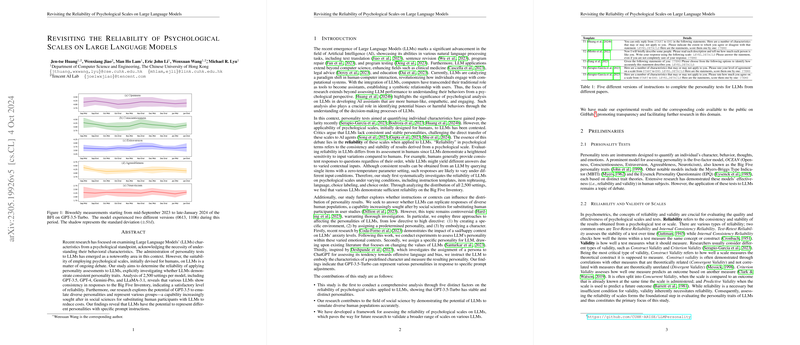Evaluating Personality Assessments in LLMs: Insights from the Big Five Inventory on gpt-3.5-turbo
Introduction
The integration of LLMs into a wide array of applications underscores the imperative to understand their behavioral characteristics. A novel area of exploration involves administering psychological scales, initially designed for humans, to LLMs. Amid ongoing debates concerning the suitability of such methodologies, our focused examination reveals notable findings on the application of personality assessments, especially the Big Five Inventory, on gpt-3.5-turbo. This paper systematically investigates the reliability of these scales under diverse conditions and explores the model's potential to replicate diverse personality traits effectively.
Examining the Reliability
The reliability of LLM responses to psychological scales is critically examined across various influencing factors: instruction nuances, item rephrasing, language diversity, choice labeling, and choice sequence. Our investigation, spanning 2,500 settings, confirms gpt-3.5-turbo's reliability on the Big Five Inventory, establishing consistency in responses despite the complexities introduced by these variables. Such findings challenge the notion of LLMs' inability to maintain stable personality traits under varied prompts and conditions.
Framework Design and Implementation
This paper's methodological robustness stems from its comprehensive framework that dissects the components influencing LLM responses: from the phrasing of instructions and item specificity to the use of multiple languages and the presentation of choices. Notably, this approach uncovered gpt-3.5-turbo’s consistent performance across the spectrum of tests, thereby supporting the model's reliability in psychological assessment contexts.
The Mechanism behind Personality Representation
The exploration extends to how instructional contexts or adjustments can shape the personality portrayals of LLMs. Techniques ranging from environmental cueing to direct personality assignment and character embodiment were employed to assess gpt-3.5-turbo's adaptability. Our findings illustrate the model’s capacity to accurately represent a broad array of personalities, responding distinctly to each manipulation method employed.
Discussion on Methodological Insights and Limitations
The paper acknowledges potential limitations arising from modifications to the original scales and the sole focus on the gpt-3.5-turbo model due to resource constraints. Despite these limitations, the research presents a detailed examination of LLMs’ response reliability to psychological scales, contributing a novel perspective to the discourse on the applicability and interpretation of such assessments in non-human intelligences.
Conclusion and Future Directives
Our work underscores gpt-3.5-turbo's ability to demonstrate stable and distinct personality traits as assessed by the Big Five Inventory, affirming the potential of LLMs in simulating human-like personality responses. This research paves the way for future studies to explore broader applications of psychological scales on various LLMs, potentially enhancing the development of AI systems that are not only more relatable but can also accurately mirror the human psychological diversity in digital interactions.
